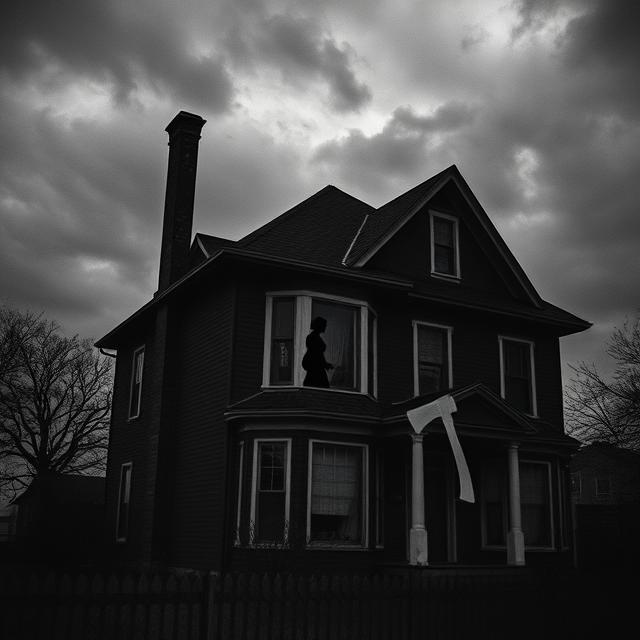The sweltering summer of 1892 in Fall River, Massachusetts, became the backdrop for a crime so brutal and bizarre that it continues to captivate and confound over a century later. Andrew Jackson Borden, a wealthy and somewhat stern businessman, and his second wife, Abby Durfee Gray Borden, were found bludgeoned to death with an axe in their own home. The prime suspect, and the only one ever tried for the murders, was Andrew’s younger daughter, Lizzie Andrew Borden. The sensational trial that followed was a media circus, fueled by societal fascination with a well-to-do woman accused of such a heinous act. Despite compelling circumstantial evidence and a motive suggested by family tensions, Lizzie Borden was acquitted, leaving behind a mystery that has solidified her place in American folklore, immortalized in rhyme and forever shadowed by the question: Did Lizzie Borden take an axe and give her parents forty whacks?
Lizzie Borden was a 32-year-old unmarried woman living in the somewhat tense household of her father, Andrew, and stepmother, Abby. The family dynamic was reportedly strained. Lizzie and her older sister, Emma, resented Abby, viewing her as an outsider who had married their father for his wealth. There were also financial disputes and a general atmosphere of discomfort within the Borden home.
In the days leading up to the murders, there were unusual events that heightened the suspicion surrounding Lizzie. She claimed that a stranger had attempted to purchase poison at a local pharmacy, a claim that was never substantiated. The day before the murders, the family, including a visiting uncle, John Vinnicum Morse, fell ill with what they suspected was food poisoning.
On the morning of August 4, 1892, John Morse left the Borden residence after breakfast. Andrew Borden departed for his business rounds. Lizzie and Abby remained in the house. Around 10:45 AM, Andrew returned home feeling unwell and lay down on a sofa in the sitting room. Shortly after 11:15 AM, Lizzie called out to the maid, Bridget Sullivan, claiming to have found her father dead. Andrew Borden had been struck multiple times in the head with an axe.
Bridget Sullivan, who had been outside washing windows and then resting in her third-floor room, recalled hearing no sounds of a struggle. While she tended to the scene, Lizzie informed her that Abby had gone out visiting a sick friend. However, Abby’s body was later discovered upstairs, in the guest bedroom, also brutally murdered with an axe, having been killed sometime before Andrew.
The immediate suspicion fell upon Lizzie. Her demeanor after the discovery of the bodies was described as strangely calm. She offered inconsistent accounts of her whereabouts during the time of the murders. She claimed to have been in the barn searching for fishing sinkers, a claim that seemed improbable given the heat and the lack of any apparent interest in fishing that day. No footprints were found in the dusty barn.
The murder weapon, a hatchet, was found in the basement, washed clean and with a broken handle. While it appeared consistent with the wounds, forensic science of the time could not definitively link it to the crime. There was also the matter of Lizzie’s clothing. Bridget Sullivan testified that Lizzie was wearing a light-colored dress that morning, but this dress was never found. Lizzie claimed to have burned an old, stained dress a few days later, a seemingly innocuous act that became highly suspicious in the context of the murders.
The inquest and subsequent trial of Lizzie Borden were a national sensation. The prosecution presented a case built largely on circumstantial evidence and the perceived motive of family resentment and financial gain. They highlighted Lizzie’s strange behavior, her inconsistent alibis, and the destruction of the dress.
The defense, however, portrayed Lizzie as a respectable woman from a prominent family, arguing that it was inconceivable that she could commit such brutal acts. They emphasized the lack of direct evidence, no eyewitnesses to Lizzie committing the murders, and no bloodstains definitively linking her to the crime. They also suggested other potential suspects, though none were convincingly established.
The jury ultimately acquitted Lizzie Borden on June 20, 1893. The verdict was met with mixed reactions, with many believing that a killer had walked free. Despite her acquittal, Lizzie Borden lived the rest of her life under a cloud of suspicion in Fall River, ostracized by much of the community. She never married and died in 1927.
The question of who truly killed Andrew and Abby Borden remains one of the most debated mysteries in American true crime. Numerous theories have emerged over the years, attempting to solve the seemingly unsolvable:
- Lizzie Borden as the Killer: Despite her acquittal, many still believe Lizzie was responsible. Theories range from a sudden fit of rage to a meticulously planned act. The “forty whacks” rhyme, though not entirely accurate to the actual number of blows, has cemented this suspicion in popular culture.
- William Borden (Andrew’s Illegitimate Son): A more recent theory suggests that William Borden, Andrew’s illegitimate son, who felt slighted by the family, could have been the killer.
- Bridget Sullivan (The Maid): Some have speculated that Bridget, who had her own grievances with the family, could have committed the murders. However, her alibi and the lack of strong evidence against her make this less likely.
- John Morse (The Uncle): His presence in the house and his movements that morning have led to some suspicion, though a solid motive and evidence are lacking.
- An Outside Intruder: The possibility of an unknown assailant has also been considered, though the lack of forced entry makes this theory less probable.
The enduring fascination with the Lizzie Borden case lies in its perplexing nature. A brutal crime in a seemingly ordinary household, a prominent suspect who was acquitted, and the lack of a definitive answer continue to fuel speculation and debate. The image of Lizzie Borden, forever linked to the axe and the unanswered question of her guilt or innocence, remains a haunting enigma in the annals of American crime.
Want to explore the shadows even deeper? For more chilling cases like this, visit SinisterArchive.com, where the legends are real.




